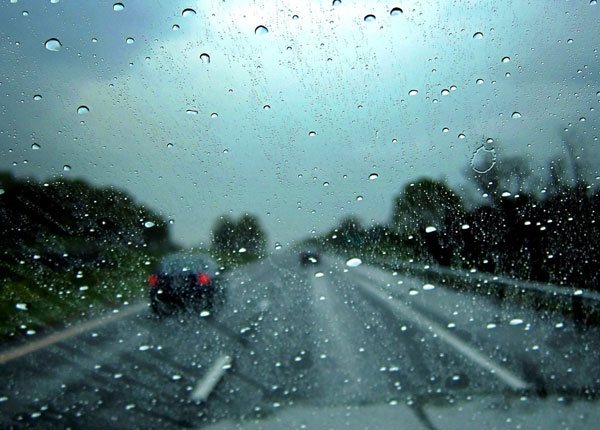
Driving in The Rain Safety Rules: Wipers, Night Driving & Heavy Downpour
Updated Nov. 16, 2020Driving in the rain can be every bit as dangerous as driving in icy or snowy conditions. Water on the road’s surface can seriously impede your vehicle control, while the rain itself impacts visibility. You must understand how to manage these challenges and drive safely during wet and rainy conditions. Every risk you face during wet and rainy weather can be diminished by reducing your speed; this should be the first action you take.
Low visibility
Like snow, rain can negatively impact your ability to see the road ahead, nearby vehicles and approaching hazards. During heavy rain you may not be able to see more than 100ft in front of your vehicle. If this is the case, you cannot safely drive more than 30mph. Keep in mind that in extremely rainy and windy conditions, you may need to pull over intermittently to clean mud and other dirt from your windshield, headlights and taillights.
To obtain maximum visibility when driving in the rain, use this guidance:
- 1

Use the right edge lines or center lines which are visible just ahead of your vehicle for guidance.
- 2

Get rid of any distractions in your vehicle (for example, switch off the radio).
- 3

Turn on your lights and windscreen wipers.
- 4

Do not switch on your hazard lights, this may lead other drivers to assume your vehicle is stationary.
- 5

Keep lights on low-beam, as high-beam may reflect off the moisture in the air and create glare.
- 6

Signal turns earlier to give other drivers who are also dealing with poor visibility a chance to register your intentions.
- 7

Avoid unpaved sections of the roadway.
- 8

Keep a lookout for other vehicles that may not have lights on.
Slippery roadway and poor traction
Water pooling on the surface of the road is bad news, though not the main cause of rain-related accidents. A surprisingly small amount of rain can make for incredibly dangerous driving conditions!
If it has not rained in a while, oil and other chemicals can build-up on the surface of the road. Fresh rain then loosens these chemicals to create a slick coating on the tarmac – perfect conditions for slipping, skidding and losing control of your vehicle. You should take particular care in hot weather, as the heat will encourage more oil to collect on the surface of the asphalt.
When the road becomes slick, you must reduce your speed by 5 to 10 mph and increase your following distance to five or six seconds. If you need to stop, avoid slamming on the brakes as this could cause a skid. Instead, apply the brakes gradually and in a controlled manner, easing off if you feel the vehicle beginning to skid. Always take bends and turns more slowly when the roadway is wet.
All roads will become are slippery when rained on, though you should take particular care when traveling on a road with a sign that says: “SLIPPERY WHEN WET.” This indicates that the road is paved with a material that can be particularly hazardous during rainstorms.
Hydroplaning
When heavy rain or poor drainage causes water to pool on the road’s surface, your tires can begin to glide on top of the water and lose contact with the road. This is called “hydroplaning” and is every driver’s worst nightmare in wet weather. Hydroplaning can cause complete loss of traction (grip on the road’s surface) and steering control. This generally occurs at high speeds, which is why slowing down during heavy rain is so important.
The risk of hydroplaning is also significant if your tires are poorly inflated or tread-worn. Good quality tires with deep tread can help to prevent hydroplaning. If you find yourself hydroplaning:
- Keep both hands firmly on the steering wheel.
- Take your foot off the gas pedal to slow down and regain traction; do not slam on the brakes or try to turn suddenly as this will make your vehicle skid.
- If you must turn, turn slowly. If you must use the brakes, brake gradually.
Driving through deep water
If you encounter standing or deep water on the roadway, the safest thing to do is leave it well alone. Pull your vehicle over and consider an alternative route to your destination or wait for the water to subside.
Never drive through an area where the water is over 30cm deep and moving swiftly. This depth may seem relatively harmless but when the current is strong, 30cm of water could easily sweep your vehicle off the road.
If you drive through rising water and your engine stalls, abandon your vehicle immediately and look for higher ground. Situations like this can quickly get out-of-hand and become life-threatening.
Dealing with wet brakes
Your brakes can become wet when there is water on the road and if this happens, they will be substantially less effective. This is caused by water between the two contacting surfaces acting as a lubricant and preventing the friction build-up needed to slow your vehicle. While ineffective brakes can be very frightening when you first attempt to use them, the problem can be rectified quickly if you keep a cool head.
If your brakes are wet, you may find they pull to one side or simply do not hold at all. Fortunately, you can dry your brakes by driving slowly, maintaining a low gear and braking gently. Softly applying the brakes should spin off any water that has accumulated and return your braking ability to normal.




